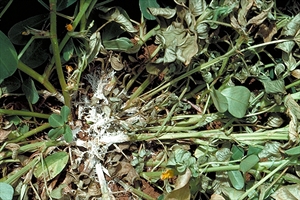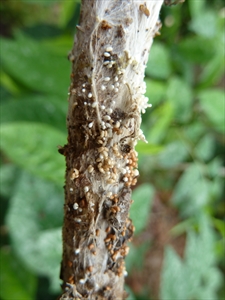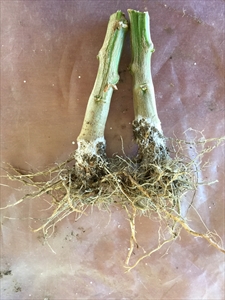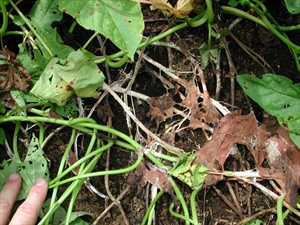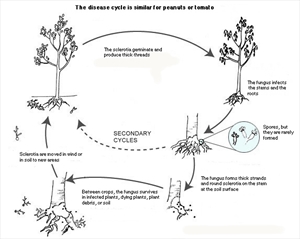Southern blight, Athelia wilt
Pacific Pests, Pathogens, Weeds & Pesticides - Online edition
Pacific Pests, Pathogens, Weeds & Pesticides
Peanut southern blight (011)
Athelia rolfsii, the sexual state of the fungus. It is also known by the asexual state, Sclerotium rolfsii. The sexual stage (Diagram) is rarely seen.
Asia, Africa, North, South, and Central America, the Caribbean, Europe, Oceania. Athelia rolfsii is recorded from Australia, Fiji, French Polynesia, Guam, New Caledonia, New Zealand, Palau, Papua New Guinea, Samoa, Solomon Islands, Tonga, Tuvalu, and Vanuatu. The disease on peanuts is recorded in Australia, Fiji, New Caledonia, Papua New Guinea, Solomon Islands, Tonga, and Vanuatu.
The fungus has a wide host range. It is common on carrot, beans, cucurbits, capsicum, peanut, sweetpotato, taro, giant taro, and other aroids, tomato, and weeds.
When the cottony growth of the fungus comes into contact with susceptible roots, leaves or stems, direct penetration occurs, but the fungus can also infect through wounds. It produces chemicals that cause soft rots in 2-4 days after infection. When the soft rots girdle the stem, the foliage wilts (Photos 1&2) and death of the plant follows soon after. The fungal growth can easily be seen with the naked eye (Photos 1-5).
About 7 days after infection, the cottony growth begins to form sclerotia (Photo 3). These are 0.5-2 mm diameter and made up of tightly packed strands of the fungus. They are white turning light brown as they mature. Sclerotia keep the fungus alive when there are no plants to infect, remaining alive for several years in soil or potting mix. Other than sclerotia, the fungus can survive between crops in the remains of plants. The life cycle is given below (Diagram).
Spread over short distances is by growth of the fungus through the soil; spread over long distances is by movement of infected plant material and infested soil. Wind carries soil containing the sclerotia.
This soilborne fungus causes important diseases. It usually infects the lower stem near the soil surface. On peanut, the first sign of the disease is a wilt of a single leaf and, soon after, the wilt of the entire plant. During warm wet weather the fungus spreads from plant to plant, and the damage can be considerable. Sclerotia develop in the cottony growth on the stem (Photo 3). On sweetpotato, cuttings are destroyed at planting (Photo 2) and later as mature vines (Photo 4). Root of giant taro (Alocasia) are attacked and plants fall over (Photo 5)
Look for the thick white cottony growth at soil level and the presence of sclerotia. Look for plants that have wilted suddenly.
CULTURAL CONTROL
The fungus has a large number of hosts so crop rotation is not a practical option. However, bananas appear resistant to infection, and maize, cassava, yam and cabbages are little affected. The following measures are important:
Before planting:
- Avoid land where there is a previous history of this disease.
- Check that plants taken from a nursery are free of the fungus.
- Treat the soil with lime; in Samoa, white coral sand has been suggested for both tomatoes and peanuts. This is best done together with ample supply of well decomposed chicken manure.
During growth:
- Remove infected plants with soil around the roots as soon as they start to wilt, taking care not to spread the fungus by dropping soil/sclerotia onto other plants.
- If a mulch is needed, use coconut leaves.
After harvest:
- Collect and remove plant debris and burn or bury it deeply.
- Where possible, plough the land deeply, or at least turn over the soil to bury the sclerotia: sclerotia do not survive for more than 45 days if buried 20-30 cm, and burying deeply also speeds up the decay of the fungus in the plant remains.
- Rotate with the crops listed above if land becomes infested with the fungus.
RESISTANT VARIETIES
There are no reports of resistant varieties of peanuts, beans and tomatoes, and the many other crops that are susceptible to the disease.
CHEMICAL CONTROL
Many fungicides have been recommended for the control of Athelia rolfsii, but they are either not available and/or too expensive for use in Pacific island countries.
AUTHORS Helen Tsatsia & Grahame Jackson
Information from (and Diagram) Mullen J (2006) Southern blight. Southern stem blight, White mold. The Plant Health Instructor. The American Phytopathological Society. (https://www.apsnet.org/edcenter/disandpath/fungalbasidio/pdlessons/Pages/SouthernBlight.aspx); and Athelia rofsii. Wikipedia. (https://en.wikipedia.org/wiki/Athelia_rolfsii); and CABI (undated) Athelia rot. Plantwise Knowledge Bank. (https://www.plantwise.org/knowledgebank/datasheet/49155#DistributionSection); and from MacKenzie E (2013) Athelia rolfsii: PaDIL - http://www.padil.gov.au; Atlas of Living Australia (undated) Athelia rolfsii (Curzi) C.C.Tu & Kimbr. (https://bie.ala.org.au/species/18134a8d-21cd-4542-bf73-83400f2dd12d). Photo 4 Mani Mua, SPC, Sigatoka Research Station, Fiji.
Produced with support from the Australian Centre for International Agricultural Research under project PC/2010/090: Strengthening integrated crop management research in the Pacific Islands in support of sustainable intensification of high-value crop production, implemented by the University of Queensland and the Secretariat of the Pacific Community.
